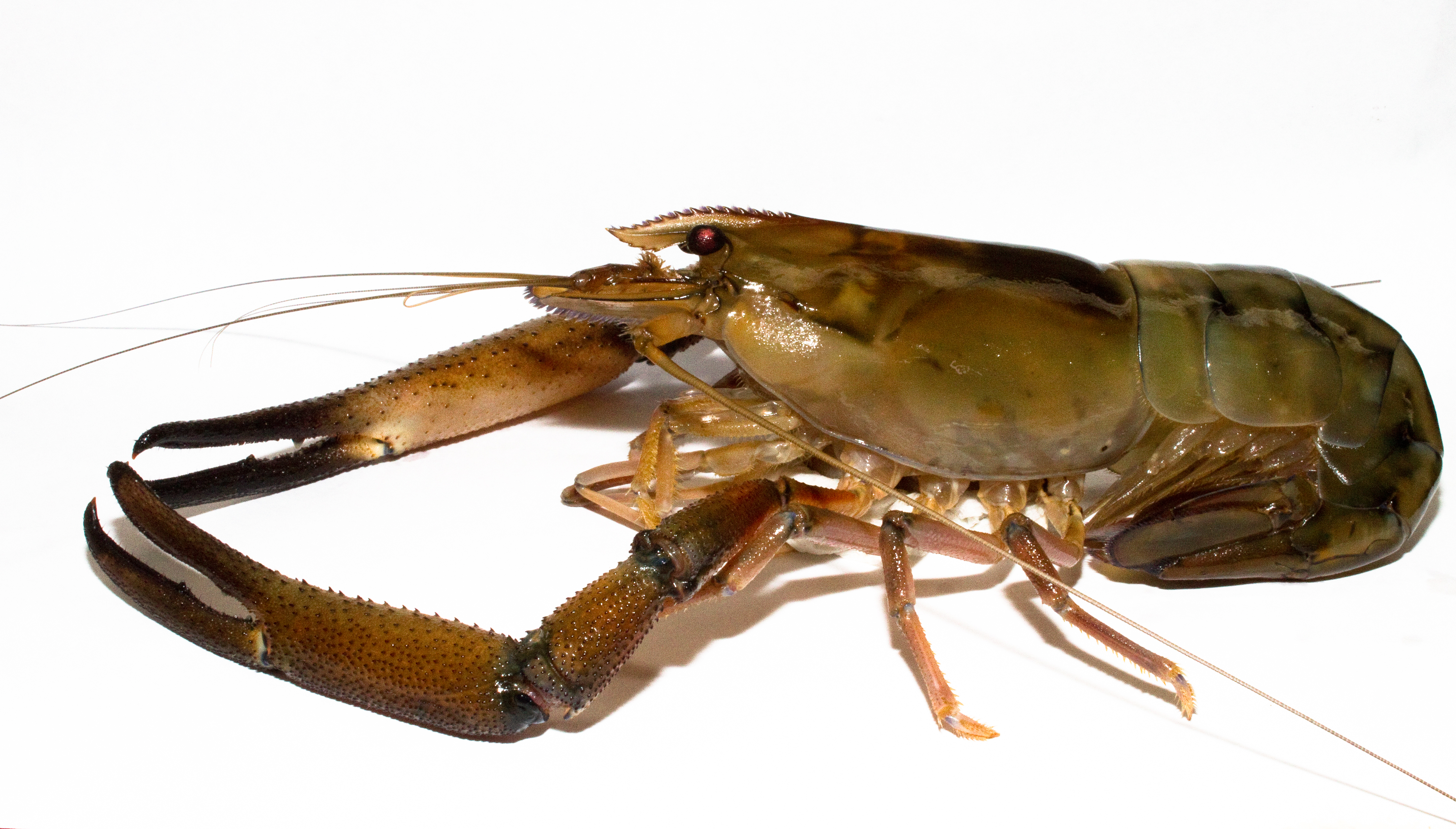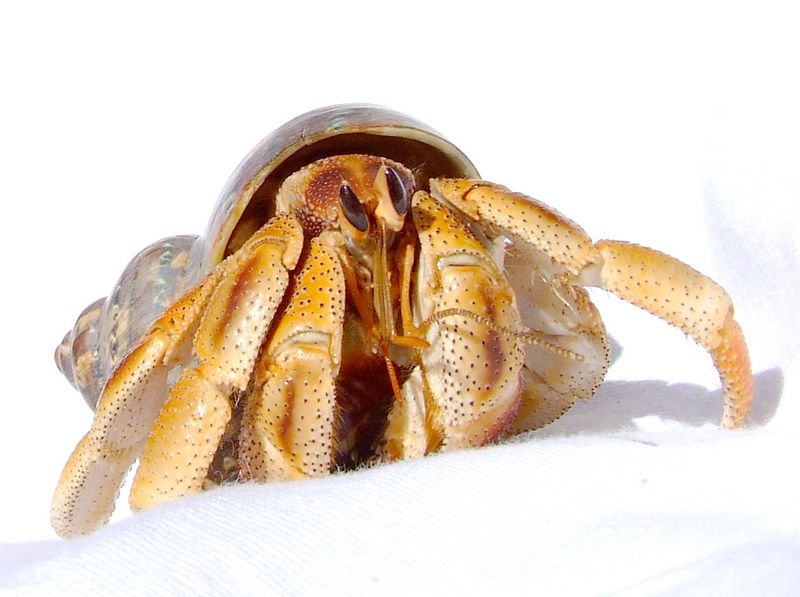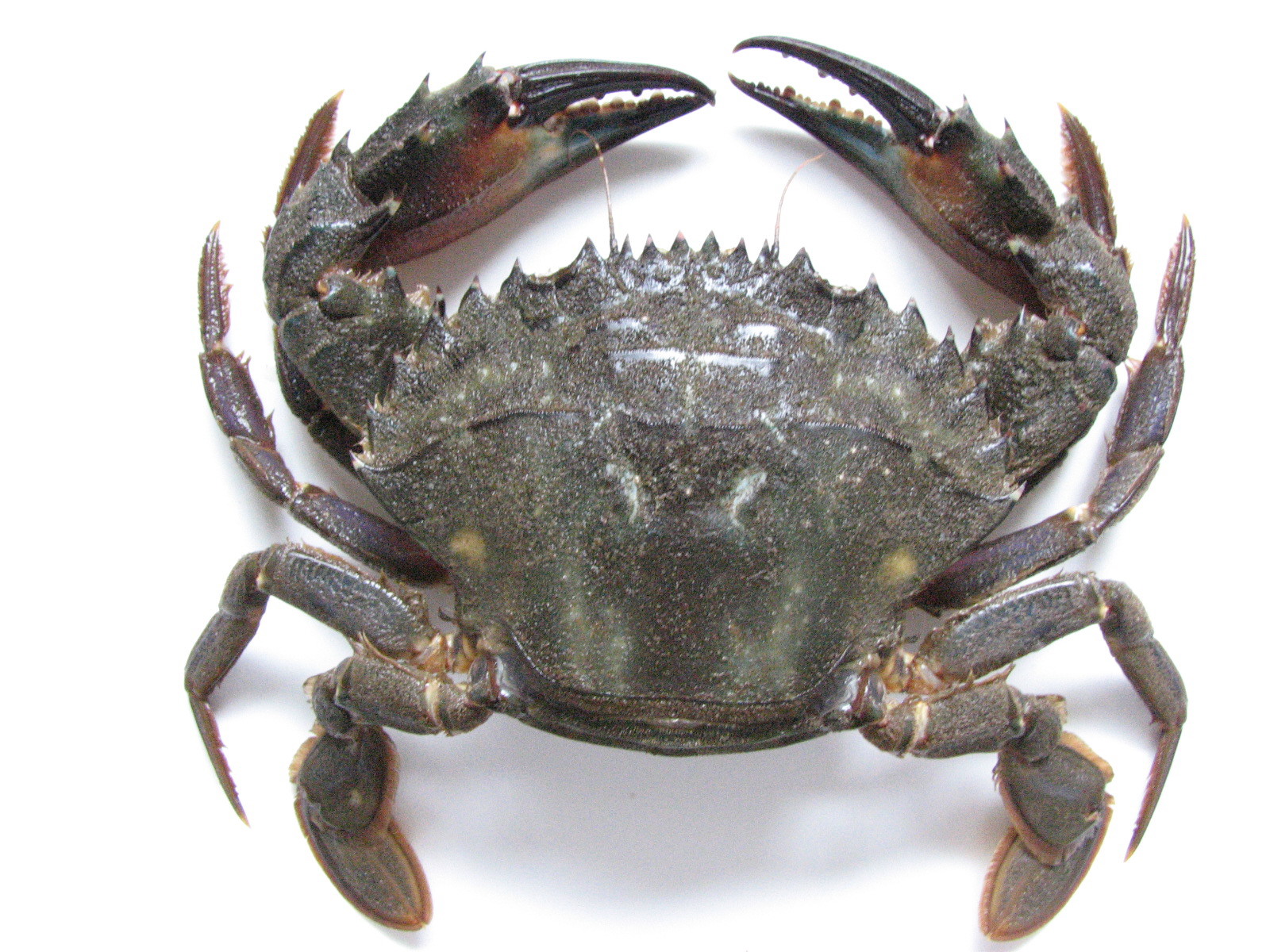|
Reptantia
Reptantia is a clade of decapod crustaceans named in 1880 which includes lobsters, crabs and many other well-known crustaceans. Classification In older classifications, Reptantia was one of the two sub-orders of Decapoda alongside Natantia, with Reptantia containing the walking forms, and Natantia containing the swimming forms (prawns, shrimp and boxer shrimp). However, in 1963 Martin Burkenroad found Natantia to be paraphyletic and invalid, and instead split Decapoda into the two sub-orders of Dendrobranchiata (prawns) and Pleocyemata. Pleocyemata contains all the members of the Reptantia (including crabs, lobsters, crayfish, and others), as well as the Stenopodidea ("boxer shrimp"), and Caridea (true shrimp). Reptantia remains a valid monophyletic grouping, but is now no longer ranked as a sub-order. Anatomy The name Reptantia means "those that walk", and contains those decapods whose primary mode of locomotion is to walk along a surface using the pereiopods rather than swi ... [...More Info...] [...Related Items...] OR: [Wikipedia] [Google] [Baidu] |
Shrimp
Shrimp are crustaceans (a form of shellfish) with elongated bodies and a primarily swimming mode of locomotion – most commonly Caridea and Dendrobranchiata of the decapod order, although some crustaceans outside of this order are referred to as "shrimp". More narrow definitions may be restricted to Caridea, to smaller species of either group or to only the marine species. Under a broader definition, ''shrimp'' may be synonymous with prawn, covering stalk-eyed swimming crustaceans with long, narrow muscular tails (abdomens), long whiskers ( antennae), and slender legs. Any small crustacean which resembles a shrimp tends to be called one. They swim forward by paddling with swimmerets on the underside of their abdomens, although their escape response is typically repeated flicks with the tail driving them backwards very quickly. Crabs and lobsters have strong walking legs, whereas shrimp have thin, fragile legs which they use primarily for perching.Rudloe & Rudloe (2009 ... [...More Info...] [...Related Items...] OR: [Wikipedia] [Google] [Baidu] |
Anomura
Anomura (sometimes Anomala) is a group of Decapoda, decapod crustaceans, including hermit crabs and others. Although the names of many anomurans include the word ''crab'', all true crabs are in the sister group to the Anomura, the Brachyura (the two groups together form the clade Meiura). Description The name Anomura derives from an old classification in which Reptantia, reptant decapods were divided into Macrura (long-tailed), Brachyura (short-tailed) and Anomura (differently-tailed). The alternative name Anomala reflects the unusual variety of forms in this group; whereas all crabs share some obvious similarities, the various groups of anomurans are quite dissimilar. The group has been moulded by several instances of carcinisation – the development of a crab-like body form. Thus, the king crabs (Lithodidae), porcelain crabs (Porcellanidae) and hairy stone crab (Lomisidae) are all separate instances of carcinisation. As decapods (meaning ''ten-legged''), anomurans have ten pe ... [...More Info...] [...Related Items...] OR: [Wikipedia] [Google] [Baidu] |
Pleocyemata
Pleocyemata is a suborder of Decapoda, decapod crustaceans, erected by Martin Burkenroad in 1963. Burkenroad's classification replaced the earlier sub-orders of Natantia and Reptantia with the monophyletic groups Dendrobranchiata (prawns) and Pleocyemata. Pleocyemata contains all the members of the Reptantia (including crabs, lobsters, crayfish, and others), as well as the Stenopodidea (which contains the so-called "boxer shrimp" or "barber-pole shrimp"), and Caridea, which contains the true shrimp. Anatomy All members of the Pleocyemata are united by a number of features, the most important of which is that the fertilisation, fertilised eggs are Wikt:incubation, incubated by the female, and remain stuck to the pleopods (swimming legs) until the zoea larvae are ready to hatch. It is this characteristic that gives the group its name. Pleocyemata also possess a Lamella (surface anatomy), lamellar gill structure as opposed to the branches found in the Dendrobranchiata. Systematics ... [...More Info...] [...Related Items...] OR: [Wikipedia] [Google] [Baidu] |
Decapoda
The Decapoda or decapods (literally "ten-footed") are an order of crustaceans within the class Malacostraca, including many familiar groups, such as crabs, lobsters, crayfish, shrimp and prawns. Most decapods are scavengers. The order is estimated to contain nearly 15,000 species in around 2,700 genera, with around 3,300 fossil species. Nearly half of these species are crabs, with the shrimp (about 3,000 species) and Anomura including hermit crabs, porcelain crabs, squat lobsters (about 2500 species) making up the bulk of the remainder. The earliest fossil decapod is the Devonian ''Palaeopalaemon''. Anatomy Decapods can have as many as 38 appendages, arranged in one pair per body segment. As the name Decapoda (from the Greek , ', "ten", and , '' -pod'', "foot") implies, ten of these appendages are considered legs. They are the pereiopods, found on the last five thoracic segments. In many decapods, one pair of these "legs" has enlarged pincers, called chelae, with the legs be ... [...More Info...] [...Related Items...] OR: [Wikipedia] [Google] [Baidu] |
Polychelida
Polychelida is an infraorder of decapod crustaceans. Fossil representatives are known dating from as far back as the Upper Triassic. A total of 38 extant species, all in the family Polychelidae, and 55 fossil species have been described. History Polychelida had traditionally been included in the infraorder Palinura, alongside the spiny lobsters and slipper lobsters (now in the infraorder Achelata). In 1995, Gerhard Scholtz and Stefan Richter of the carried out a phylogenetic study of the "Reptantia", and concluded that "Palinura" was paraphyletic. They therefore abandoned that taxon and introduced instead the new clade Polychelida. Classification Polychelida belongs to the group Reptantia, which consists of the walking/crawling decapods (lobsters and crabs). Polychelida is the sister clade to the infraorder Astacidea, which contains the "true" lobsters and crayfish. The cladogram below shows Polychelida's placement within the larger order Decapoda, from analysis by Wolfe '' ... [...More Info...] [...Related Items...] OR: [Wikipedia] [Google] [Baidu] |
Achelata
The Achelata is an infra-order of the decapod crustaceans, holding the spiny lobsters, slipper lobsters and their fossil relatives. Description The name "Achelata" derives from the fact that all the members of this group lack the chelae (claws) that are found on almost all other decapods (from the Ancient Greek , = "not", , = "claw"). They are further united by the great enlargement of the second antennae, by the special "phyllosoma" form of the larva, and by a number of other characters. Classification and fossil record The infraorder Achelata belongs to the group Reptantia, which consists of the walking/crawling decapods (lobsters and crabs). The cladogram below shows Achelata's placement within the larger order Decapoda, from analysis by Wolfe ''et al.'', 2019. Achelata contains the spiny lobsters (Palinuridae), the slipper lobsters (Scyllaridae) and the furry lobsters (Synaxidae, now usually included in Palinuridae), as well as two extinct families, Cancrinidae a ... [...More Info...] [...Related Items...] OR: [Wikipedia] [Google] [Baidu] |
Axiidea
Axiidea is an infraorder of decapod crustaceans. They are colloquially known as mud shrimp, ghost shrimp, or burrowing shrimp; however, these decapods are only distantly related to true shrimp. Axiidea and Gebiidea are divergent infraoders of the former infraorder Thalassinidea. These infraorders have converged ecologically and morphologically as burrowing forms.Dworschak, Peter C. (2012). ''Treatise on Zoology - Anatomy, Taxonomy, Biology. The Crustacea, Volume 9 Part B''. BRILL. pp. 109–100. . Based on molecular evidence as of 2009, it is now widely believed that these two infraorders represent two distinct lineages separate from one another. Since this is a recent change, much of the literature and research surrounding these infraorders still refers to the Axiidea and Gebiidea in combination as "thalassinidean" for the sake of clarity and reference. This division based on molecular evidence is consistent with the groupings proposed by Robert Gurney in 1938 based on larva ... [...More Info...] [...Related Items...] OR: [Wikipedia] [Google] [Baidu] |
Natantia
Natantia (Boas, 1880) is an obsolete taxon of decapod crustaceans, comprising those families that move predominantly by swimming – the shrimp (comprising Caridea and Procarididea), prawns ( Dendrobranchiata) and boxer shrimp. The remaining Decapoda were placed in the Reptantia, and consisted of crabs, lobsters and other large animals that move chiefly by walking along the bottom. The division between Natantia and Reptantia was replaced in 1963, when Martin Burkenroad erected the suborder Pleocyemata Pleocyemata is a suborder of decapod crustaceans, erected by Martin Burkenroad in 1963. Burkenroad's classification replaced the earlier sub-orders of Natantia and Reptantia with the monophyletic groups Dendrobranchiata (prawns) and Pleocyemata. ... for those animals that brood their eggs on the pleopods, leaving Dendrobranchiata for the prawns. Under this system, Natantia is a paraphyletic group. Burkenroad's primary division of Decapoda into Dendrobranchiata and Pleocyema ... [...More Info...] [...Related Items...] OR: [Wikipedia] [Google] [Baidu] |
Crab
Crabs are decapod crustaceans of the infraorder Brachyura, which typically have a very short projecting "tail" (abdomen) ( el, βραχύς , translit=brachys = short, / = tail), usually hidden entirely under the thorax. They live in all the world's oceans, in freshwater, and on land, are generally covered with a thick exoskeleton, and have a single pair of pincers. They first appeared during the Jurassic Period. Description Crabs are generally covered with a thick exoskeleton, composed primarily of highly mineralized chitin, and armed with a pair of chelae (claws). Crabs vary in size from the pea crab, a few millimeters wide, to the Japanese spider crab, with a leg span up to . Several other groups of crustaceans with similar appearances – such as king crabs and porcelain crabs – are not true crabs, but have evolved features similar to true crabs through a process known as carcinisation. Environment Crabs are found in all of the world's oceans, as well as in fresh w ... [...More Info...] [...Related Items...] OR: [Wikipedia] [Google] [Baidu] |
Dendrobranchiata
Dendrobranchiata is a suborder of Decapoda, decapods, commonly known as prawns. There are 540 extant species in seven families, and a fossil record extending back to the Devonian. They differ from related animals, such as Caridea and Stenopodidea, by the branching form of the gills and by the fact that they do not brood their eggs, but release them directly into the water. They may reach a length of over and a mass of , and are widely shrimp fishery, fished and shrimp farm, farmed for human consumption. Shrimp and prawns While Dendrobranchiata and Caridea belong to different Order (biology), suborders of Decapoda, they are very similar in appearance, and in many contexts such as commercial farming and Fishery, fisheries, they are both often referred to as "shrimp" and "prawn" interchangeably. In the United Kingdom, the word "prawn" is more common on menus than "shrimp", while the opposite is the case in North America. The term "prawn" is also loosely used to describe any large s ... [...More Info...] [...Related Items...] OR: [Wikipedia] [Google] [Baidu] |
Gebiidea
Gebiidea is an infraorder of Decapoda, decapod crustaceans. Gebiidea and Axiidea are divergent infraoders of the former infraorder Thalassinidea. These infraorders have converged Ecology, ecologically and Morphology (biology), morphologically as burrowing forms.Dworschak, Peter C. (2012). ''Treatise on Zoology - Anatomy, Taxonomy, Biology. The Crustacea, Volume 9 Part B''. BRILL. pp. 109–100. . Based on molecular evidence as of 2009, it is now widely believed that these two infraorders represent two distinct lineages separate from one another. Since this is a recent change, much of the literature and research surrounding these infraorders still refers to the Axiidea and Gebiidea in combination as "thalassinidean" for the sake of clarity and reference. This division based on molecular evidence is consistent with the groupings proposed by Robert Gurney in 1938 based on larval developmental stages.Pohle, G. and Santana, W., Gebiidea and Axiidea (=Thalassinidea), in ''Atlas of Cru ... [...More Info...] [...Related Items...] OR: [Wikipedia] [Google] [Baidu] |
Astacidea
Astacidea is an infraorder of decapod crustaceans including lobsters (though not "lobsters" such as the spiny lobster etc.), crayfish, and their close relatives. Description The Astacidea are distinguished from most other decapods by the presence of chelae (claws) on each of the first three pairs of pereiopods (walking legs), the first of which is much larger than the remaining two pairs. The last two pairs of pereiopods are simple (without claws), except in ''Thaumastocheles'', where the fifth pereiopod may have "a minute pincer". Distribution Members of the infraorder Astacidea are found throughout the world – both in the oceans and in fresh water – except for mainland Africa and parts of Asia. Classification Astacidea belongs to the group Reptantia, which consists of the walking/crawling decapods (lobsters and crabs). Astacidea is the sister clade to the infraorder Polychelida, a small group of crustaceans restricted to deep waters. The cladogram below shows Astacidea ... [...More Info...] [...Related Items...] OR: [Wikipedia] [Google] [Baidu] |








.jpg)


